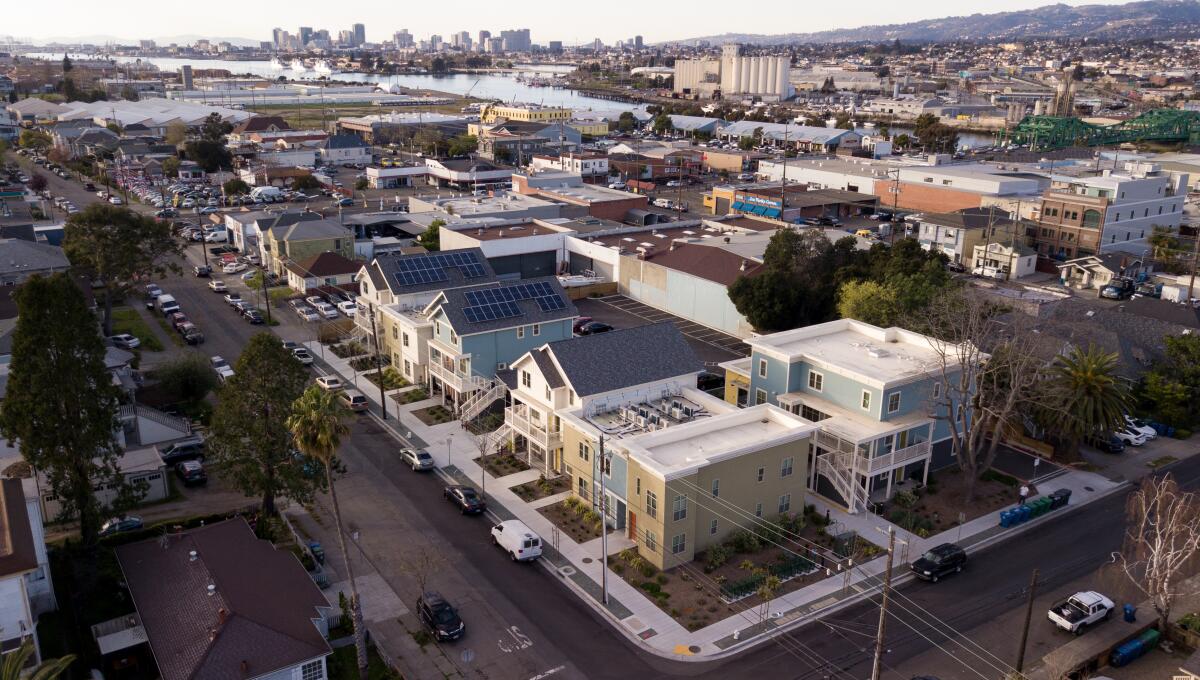Housing advocacy group starts petition after O.C. cities sue state over housing development plans

- Share via
A group that advocates for more homebuilding and lower-cost housing in Orange County started a petition in support of a state plan to find space by 2029 for about 1.34 million homes in Southern California, including about 183,000 in Orange County.
The petition is in response to a lawsuit filed by the Orange County Council of Governments that takes issue with the state-mandated figure. The planning agency, which is made up of Orange County cities, claims in the lawsuit that the SCAG region’s share should be only 651,000 housing units.
“This lawsuit runs counter to the interest of the most at-risk for displacement and homelessness,” the petition says. “Orange County needs more housing. We need subsidized affordable housing for low & very-low-income families and service sector workers. We need ‘missing-middle’ townhomes and condos near jobs for millennial-aged teachers, healthcare workers, and emerging professionals.
”... We are signing this petition to tell you that Orange County cities and the Southern California region as a whole need all 1.3 M new homes as assigned by the 6th cycle [Regional Housing Needs Assessment]. Please drop your lawsuit. Instead, please work with cities’ staff and residents through the housing elements process to find sites suitable to build new housing.”
The petition was started by People for Housing Orange County, which is part of the YIMBY Action Network. The national nonprofit is made up of chapters in San Francisco, Denver, Atlanta and Chicago, among other locations. YIMBY stands for “yes in my backyard,” a response to the commonly used term NIMBY, which stands for “not in my backyard,” and refers to residents who oppose development.
“There’s a lot of people in Orange County that recognize that we do have a housing shortage and that suing HCD is a waste of time and money,” said Elizabeth Hansburg, co-founder and executive director of People for Housing O.C. “Those efforts and energies would be better put to working with HCD and working with your local government, your planning department, your residents and elected officials to find viable sites for the new housing that we need.”
The state number was finalized in March by the Southern California Assn. of Governments as part of the Regional Housing Needs Assessment. SCAG, which is made up of local officials and addresses regional issues, was tasked with allocating these housing goals to each city. The state has mandated that six counties in Southern California, including Orange and Los Angeles, will need to find zoning for the homes.
The process has been mired in controversy for the past year. Cities have contested the numbers allocated to them, citing the difficulty of reaching such lofty housing goals. Nearly half the cities in Orange County filed appeals with SCAG, but all were denied.
An Orange County nonprofit recently broke ground on a project to transform a motel into a permanent supportive housing facility, with about half of the units set aside for the mentally ill.
With the lawsuit, the cities have taken the fight directly to the California Department of Housing and Community Development.
“Orange County jurisdictions are currently following the state’s housing statutes and are working hard to update housing elements to meet the number of housing units assigned to them via the 6th Cycle Regional Housing Needs Assessment (RHNA) methodology,” reads a statement from Trevor O’Neil, Anaheim councilman and chair of the council of governments. “However, OCCOG recognizes that Orange County’s citizens and taxpayers deserve to be treated fairly under the law.
“Therefore, on behalf of its members, OCCOG is challenging the Regional Determination established by the California Department of Housing and Community Development (HCD). Simply, HCD did not follow the statutes outlined in state law to develop the projected number of units needed in the next eight years to adequately house Orange County’s population.”
According to the lawsuit, the council of governments believes that the state used wrong population forecast data in determining the housing needs. Also, the lawsuit contends that the state did not use comparable regions when evaluating household overcrowding and cost-burden rates. Rather, the HCD used national averages, the lawsuit says.
HCD spokeswoman Alicia Murillo said this week that she couldn’t provide a comment on the lawsuit. However, she provided a statement on the general contention of the council of governments.
“HCD stands by the credibility and legality of its Regional Housing Needs Determinations for the sixth cycle housing element throughout the state,” she said. “The methodology accurately captures housing needs in compliance with legislation passed in 2017 and 2018.”
The petition currently has just over 100 signatures, but Hansburg is hoping to get anywhere from 500 to 1,000.
She said part of the difficulty in getting enough people behind the housing movement is its complexity. She pointed out that it’s not as easy for people to understand as a “save the whales” campaign.
Also, there is a contingent — the “NIMBYs” — who push back on development of any kind.
“Southern California has a nostalgia for low-density suburban development patterns where everyone has their single-family home,” Hansburg said. “If you read the post-World War II descriptions about how good life in California was, it’s all based on that idea that everybody has space. California has been a land of opportunity for a lot of people, and it still continues to be a land of opportunity, but we don’t have the space that we used to for everyone to come in and affordably own their own single-family home. We have to build higher-density housing, and that goes against the mindset of a lot of folks who like it the way it is.
“I think for some people, there’s an association of apartments with low-income people, people of color, and I think there is some element of racism and classism.”
All the latest on Orange County from Orange County.
Get our free TimesOC newsletter.
You may occasionally receive promotional content from the Daily Pilot.






